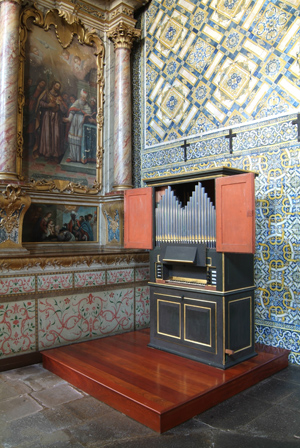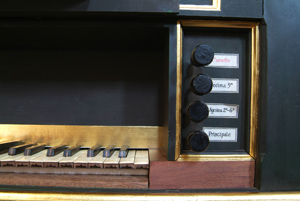 Thursday, 25 October, 9.30, p.m.
Thursday, 25 October, 9.30, p.m.
Church and Convent of Santa Clara
Maurizio Croci, organ
During the second half of the 16th century, Venice was the most important centre for Italian music, and Andrea Gabrieli, organist of the Basilica of St Mark, was without any doubt one of the most representative figures. He exercised a considerable influence on many Venetian and South German composers. The Toccata del nono tono is a virtuoso work of large proportions, structured in several sections, one of them a fugato. Gabrieli was one of the first composers to introduce imitative sections into his toccatas.
The works of Girolamo Frescobaldi represents the highest point of the Italian art of composition for keyboard. His style was profoundly influenced by the “new” vocal music of the beginning of the 17th century, practiced by Caccini, Monteverdi, Peri and others. In the same way that the “new” vocal music made itself the “servant” of the poetry, so, in his toccatas, Frescobaldi maintained a free performance style, unmeasured, ruled not by the barline but bu the affetti dell’animo. The Cento partite are among the most significant of Frescobaldi’s works, combining musical forms and metrical structures in a surprising series of variations on a basso ostinat. The three short pieces included in this programme are preserved in an autograph source recently discovered at the National Library of Paris.
The two pieces by Bach and the Prelude by Böhm that make up the last part of the programme come from the same sources, the Andreas Bach Buch and the Moeller manuscript. These are two collections copied, with others, buy Bach’s eldest brother, Johann Christoph, and they are from the student years of the Johann Sebastian. They contain works by masters such as Reincken, Bruhns, Buxtehude, Pachelbel and Böhm, who profoundly influenced the young Bach, as well as his first attempts at composition.
Georg Böhm, active in Hamburg and in Lüneburg, is without any doubt amongst the first composers to introduce the French style into his works. Böhm very probably came to know French music in Hamburg, where Kusser, a pupil of Lully, directed French and Italian operas. The Praeludium in G minor mixed French grace with typically German intensity and profundity. The structure of the work is tripartite: prelude, fugue and postlude. Böhm was a true master for the young Bach. Between 1700 and 1703, Bach was a pupil at the Michaelisschule in the city of Lüneburg. During the same period, Böhm was organist there, and Bach probably his pupil. The very recent discovery (in 2006) in Weimar of the oldest autograph document of Bach shows that he had access to Böhm’s library. This manuscript contains, amongst other things, a copy made by Bach of the famous choral by Johann Adam Reincken An Wasserflüssen Babylon. Bach notes that he copied the piece in Böhm’s house in 1700. The Sonata and Aria variata alla maniera italiana are youthful works by Bach. The Italian aspect of the set of variations resides probably in the instrumental character of the melody and the typically violinistic treatment of its nine variations.
Maurizio Croci
Organ Recital
Andrea Gabrieli (1533-1585)
Toccata del nono tono
Canzon Ariosa
Girolamo Frescobaldi (1583-1643)
Toccata III (Libro primo, 1637)
Aria detta la Frescobalda (Libro secondo, 1637)
Cento partite sopra passacagli (Aggiunta, 1637)
Aria detta la Frescobalda – Monicha – Balletto (Autógrafo de Paris)
Johann Sebastian Bach (1685-1750)
Sonata in A minor, BWV 967
Aria variata alla man[iera] Italiana, BWV 989
Georg Böhm (1661-1733)
Capriccio
Prealudium in g
Participants
|
Maurizio Croci was born in Varese (Italy). He holds diplomas in organ and harpsichord studies from the conservatoires of music of Milan and Trent (Italy) and spent four years at the Schola Cantorum in Basle (Switzerland) on advanced courses in organ and harpsichord under Jean-Claude Zehnder and Andrea Marcon. He also graduated in musicology at Fribourg University in Switzerland under Prof. Luigi Ferdinando Tagliavini. Prize-Winner of the Paul Hofhaimer international competition in Innsbruck (1998), Mr. Croci has concertized throughout Europe, Russia and Japan, performed J.S. Bach’s complete organ works in Bern to mark the 250th anniversary of the composer’s death and recorded several CDs. In 2011, he recorded Andrea Gabrieli’s organ works on the Marco Fratti organ in the Holy Trinity Basilica in Bern for RSI Rete Due. Maurizio Croci gives Masterclasses on early keyboard music, and sits on the jury of international organ competitions (Alkmaar, Toulouse, Landsberg, Borca di Cadore). He is currently working as Organ Professor at the Haute Ecole de Musique (HEMU) in Lausanne (Switzerland), Harpsichord Professor and Director of the Early Music department of the Milano Civica Scuola di Musica, organist at the Basilica of the Holy Trinity in Bern and of the Collège St-Michel in Fribourg. Maurizio Croci is the artistic director of the Académie d’Orgue de Fribourg and sits on the artistic directors board of ECHO (European Cities of Historical Organs, www.echo-organs.org). |
Notes about the Organ
 Church and Convent of Santa Clara, Funchal
Church and Convent of Santa Clara, Funchal
The church of Santa Clara had acquired a small positive organ with Italo-Iberian characteristics in the 18th century. With the extinction of the religious orders and the subsequent sale of the congregation’s goods, the organ was also put up for sale, being purchased by a certain Romano de Santa Clara, who kept it in a wing of the dissolved convent. In 1921 he gave it to the fraternity of Santa Clara, so that it could once more be put to service in the worship of the church. In October 1923 the task of ‘repairing’ it was put in the hands of the musicians César R. Nascimento and Guilherme H. Lino, who completed the work in November of the following year.
Unused and badly damaged for many years, this instrument of considerable historical value underwent a major restoration by Dinarte Machado on the basis of proper criteria drawn from a knowledge of the organ-building practices of the instrument’s period. This was completed in 2001. The poor state of the instrument, completely disfigured, required a rigorous, in-depth study on which to base this restoration. Thus we see how from the outset Dinarte Machado went to considerable pains in the course of this restoration.
Manual (C, D, E, F, G, A, Bb-c’’’)
Principale (c#’-c’’’)
Ottava (4’)
Quintadecima
Decimanona
Vigesimaseconda e Trigesimasesta
Flauto 8’
Flauto 4’
Cornetto (c#’-c’’’)
 Maurizio Croci
Maurizio Croci